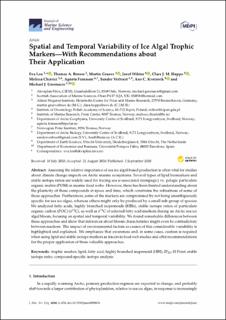Spatial and temporal variability of ice algal trophic markers—with recommendations about their application
| dc.contributor.author | Leu, Eva | |
| dc.contributor.author | Brown, Thomas A | |
| dc.contributor.author | Graeve, Martin | |
| dc.contributor.author | Wiktor, Jozef | |
| dc.contributor.author | Hoppe, Clara J.M. | |
| dc.contributor.author | Chierici, Melissa | |
| dc.contributor.author | Fransson, Agneta | |
| dc.contributor.author | Verbiest, Sander | |
| dc.contributor.author | Kvernvik, Ane Cecilie | |
| dc.contributor.author | Greenacre, Michael | |
| dc.date.accessioned | 2020-11-25T11:21:50Z | |
| dc.date.available | 2020-11-25T11:21:50Z | |
| dc.date.created | 2020-11-14T17:43:06Z | |
| dc.date.issued | 2020 | |
| dc.identifier.citation | Journal of Marine Science and Engineering. 2020, 8:676 (9), 1-24. | en_US |
| dc.identifier.issn | 2077-1312 | |
| dc.identifier.uri | https://hdl.handle.net/11250/2689549 | |
| dc.description.abstract | Assessing the relative importance of sea ice algal-based production is often vital for studies about climate change impacts on Arctic marine ecosystems. Several types of lipid biomarkers and stable isotope ratios are widely used for tracing sea ic-associated (sympagic) vs. pelagic particulate organic matter (POM) in marine food webs. However, there has been limited understanding about the plasticity of these compounds in space and time, which constrains the robustness of some of those approaches. Furthermore, some of the markers are compromised by not being unambiguously specific for sea ice algae, whereas others might only be produced by a small sub-group of species. We analyzed fatty acids, highly branched isoprenoids (HBIs), stable isotope ratios of particulate organic carbon (POC) (δ13C), as well as δ13C of selected fatty acid markers during an Arctic sea ice algal bloom, focusing on spatial and temporal variability. We found remarkable differences between these approaches and show that inferences about bloom characteristics might even be contradictory between markers. The impact of environmental factors as causes of this considerable variability is highlighted and explained. We emphasize that awareness and, in some cases, caution is required when using lipid and stable isotope markers as tracers in food web studies and offer recommendations for the proper application of these valuable approaches. | en_US |
| dc.language.iso | eng | en_US |
| dc.title | Spatial and temporal variability of ice algal trophic markers—with recommendations about their application | en_US |
| dc.type | Peer reviewed | en_US |
| dc.type | Journal article | en_US |
| dc.description.version | publishedVersion | en_US |
| dc.source.pagenumber | 1-24 | en_US |
| dc.source.volume | 8:676 | en_US |
| dc.source.journal | Journal of Marine Science and Engineering | en_US |
| dc.source.issue | 9 | en_US |
| dc.identifier.doi | 10.3390/jmse8090676 | |
| dc.identifier.cristin | 1847976 | |
| cristin.ispublished | true | |
| cristin.fulltext | original | |
| cristin.qualitycode | 1 |
Tilhørende fil(er)
Denne innførselen finnes i følgende samling(er)
-
Articles [3001]
-
Publikasjoner fra CRIStin [3025]
